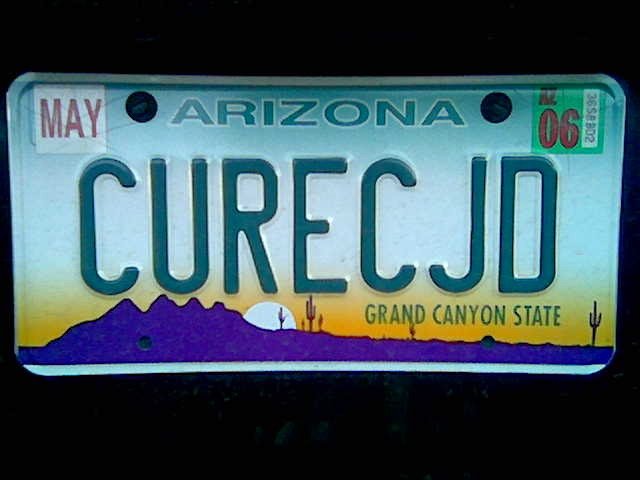February 25, 2007
Dear Friends:
I have just returned from a very interesting meeting in Calgary, Alberta, Canada. It was the first international meeting of the one-year-old PrioNet Canada organization. The meeting was planned by Dr. Neil Cashman, Director of the PrioNet.
PrioNet Canada is funded by the Canadian government and has been set up to address all possible areas affected by the discovery of endemic Canadian BSE in 2003. A $35M grant has allowed Dr. Cashman and his group to set up a network of collaborations including CJD science and possible early detection tests and treatments, the affects of BSE on farmers including socio economic and psychological, Chronic Wasting Disease, as well as concerned government representatives.
Some of the speakers and attendees are good friends of the CJD Foundation and have been presenters at some of our conferences including Dr. Robert Will, Dr. Jiri Safar, Dr. Robert Rohrer, Dr. Pierluigi Gambetti and Dr. Neil Cashman.
One of the very impressive elements of the meeting was the inclusion of a large group of young research students and research assistants. Many of them were there to present their work, most of which was reaching in scope.
I was honored to have been asked to present the welcome plenary address on Sunday night. This meant that the patients and families, on whose behalf the attendees were working, were acknowledged. The title of my talk was “The Human Side of CJD, Making a Difference Together.” I focused on trying to make all of us real and relevant to the audience.
I was not only impressed but also a little jealous of this small country that seems to have learned from the tragedies of the past and is determined not to let history repeat itself within their borders. How ironic was it that I came back to work on Thursday morning only to read an article from the Seattle Times, Feb. 22, reporting that the USDA is planning to close their BSE testing lab in Pullman, Washington on March 1. “Despite increasing concerns”, the article goes on to state, the USDA “has scaled back mad cow testing by more than 90 percent and backed off plans for a mandatory animal tracking system” because testing and tracking are too costly given the rarity of the disease”.
How does the USDA know that BSE is so rare when in July they scaled back testing from 750,000 head of cattle destined for the U.S. food chain to 40,000? The real issues seem to be ignored. Issues such as:
*Sick or “downer” cattle are often buried on the farm because there is no incentive for farmers to have these animals tested for BSE.
*Downer cows are often overlooked due to overcrowded conditions in slaughter facilities.
*Too many special interest groups are exerting pressure
To name only a few
Just as a reminder, a small group of us met with Mike Johanns, Secretary of Agriculture in July, he indicated that there wasn’t much concern about BSE on the part of the USDA. We asked him to please continue BSE testing at the 750,000 level, reminding him that 35M head of cattle were slaughtered for food in the U.S. each year. Less than a week after our visit he announced the testing cutback to 40,000. The math defies imagination!
I am now asking you to help make this an issue. Please call or write your Congressmen/women and Senators and express your concerns and displeasure at the closing of a BSE testing lab (there are three more slated for closure soon). We have just elected a more independent Congress - ask them for help. Tell them that you voted them in office to work on your behalf not on the behalf of special interest groups. I feel very strongly that unless we speak out now our children and grandchildren may be the beneficiaries not only of failed policies causing unsafe meat but also of the possible tragic fallout of endemic cases of vCJD.
On another topic, we are moving the CJD Foundation office this Wednesday, February 28. We are only going down the street but are gaining more space for basically the same rent. Our phone numbers will remain the same. We hope there won’t be any lapse in phone service but just in case we have made arrangements for the calls to be diverted to another number for a few days.
Please look at the left hand index on our website homepage, www.cjdfoundation.org for information about “Captain Bills Cycle Squad Ride for CJD.” This exciting biking fundraiser is being planned by Nick and Abby Webb in memory of Abby’s father, Bill Davis, who died of CJD in 2006. It will take place on June 2, 2007 and offers a wonderful opportunity to ride around beautiful Lake Tahoe and to raise money to help us continue our work. Contact information is listed on the page.
We will be sending out conference information soon. Please plan to join us for our fifth Annual CJD Foundation Family Conference July 6-8 in Washington D.C. We will begin with an informal reception on the evening of July 6th, and continue on Saturday and Sunday July 7th and 8th with presentations by leading researchers who will tell us about their exciting work as well as reports from representatives of families and support organizations around the world. On Monday, July 9th, we conduct our advocacy day to visit Capitol Hill and talk about our concerns to our individual representatives.
I send you all my warmest regards and hope to see you in Washington in July
Sincerely,
Florence





